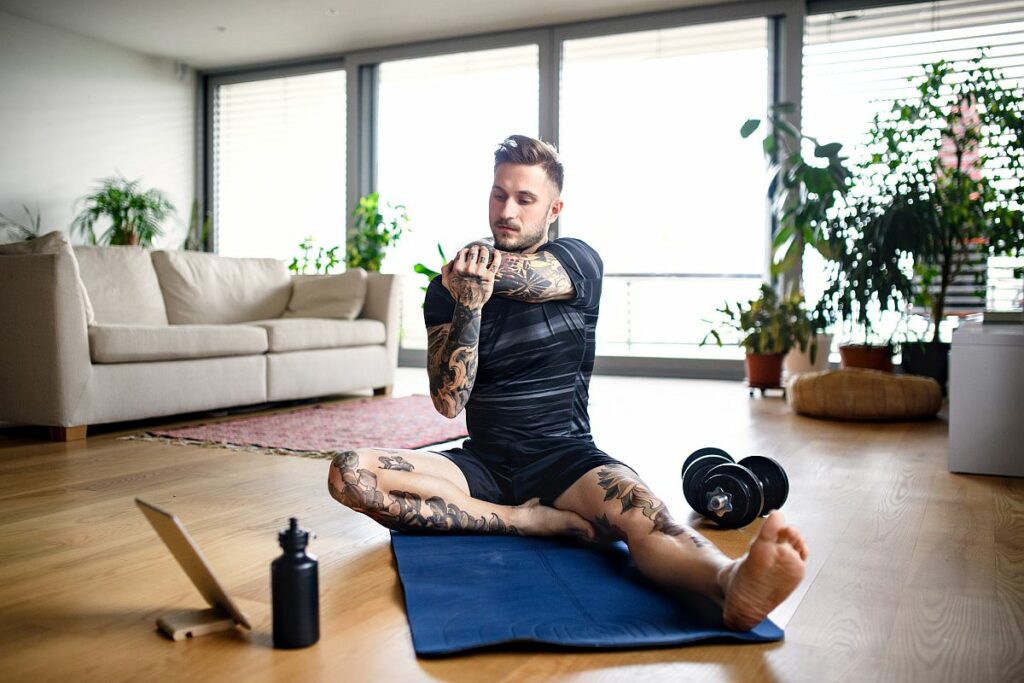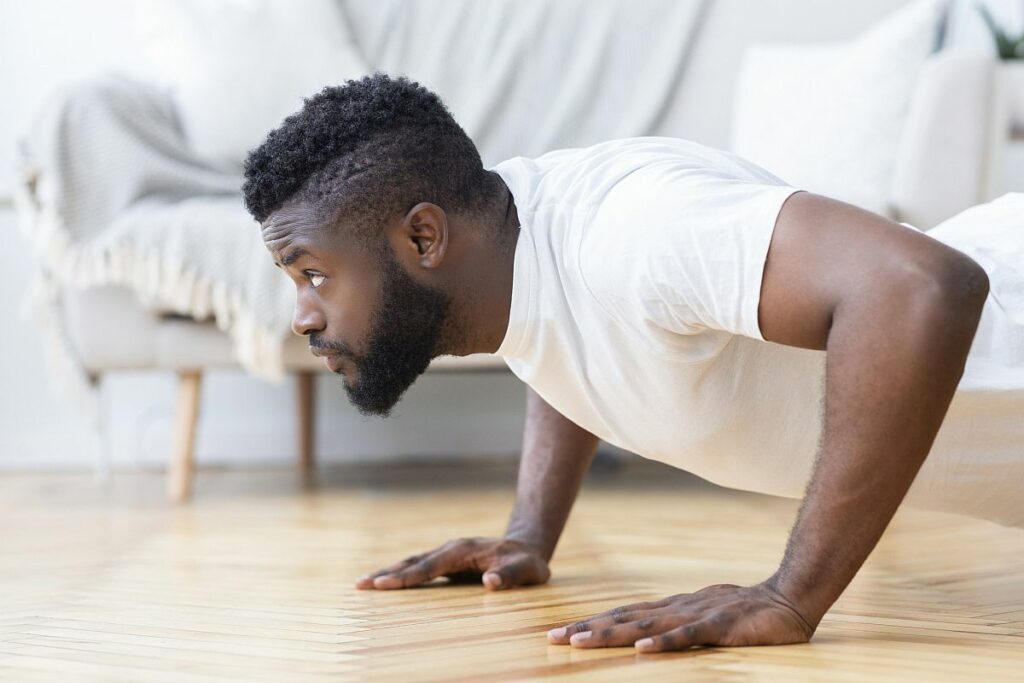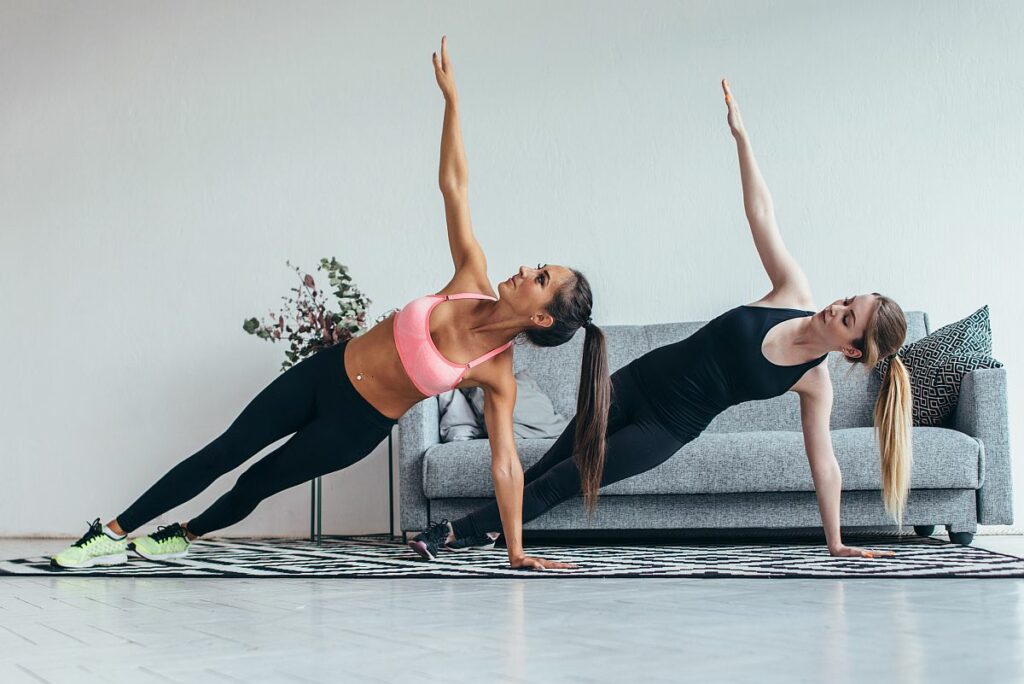The global pandemic has created unexpected challenges for gym-goers worldwide. Many athletes have experienced several gym shutdowns and the cancellation of events they’ve been training for. The bright side is that the boredom of lockdown has inspired many to start working out to build muscle at home.
Working out is just a small part of the overall equation when determining how to build muscle at home.
Here’s what you need to do to create an effective routine and maximize your gains with at-home workouts.

In a rush? Here’s a rundown of what you can read today.
- Key ingredients to build muscle at home
- The challenges of home workouts
- Example home workouts to build muscle
- Conclusions
How to Build Muscle at Home: The Key Ingredients
You could work out every day and not gain much muscle. Several things are required for optimal muscle growth, whether you’re home or at the gym.
Here are the five pillars of building muscle at home.
Caloric Surplus
One of the most important aspects of building muscle at home is providing your body with enough fuel to grow and repair. Accepting this scientific reality is especially important for figuring out how to build muscle fast for females at home, as fitness marketing often promotes eating less.
The challenge is finding your balance between enough calories and too much. Start by monitoring your caloric intake to determine your maintenance intake: the calories you need to stay the same weight. Add an additional 200-300 calories a day to start, and track your measurements, adjusting as needed.
Using a basic calorie calculator can help as a starting point, but they have a significant margin of error. Many factors beyond your basic physical characteristics impact your metabolism, such as your body type and hormones. For example, when determining how to build muscle at home for skinny guys with an ectomorphic body type, the caloric surplus needs could be significantly higher than they would for the average adult male.
The best way to find your caloric intake for muscle building is to track the results and make small adjustments over time.
Sufficient Lean Protein
Beyond looking at the overall caloric intake, it’s also important to drill down into macronutrients— protein, in particular. Athletes trying to build muscle should consume 1.6-1.8g per kg of body weight per day, or 0.75-1.0g per pound, though many athletes report consuming more. This metric is still a good starting point for targeted protein consumption.
Taking protein supplements can help you fulfill any nutrient gaps in your diet to reach your daily targets. However, it’s always preferable to eat whole, nutrient-rich foods before supplementing. Some of the best sources of lean protein include:
- Fish and seafood
- Venison
- Poultry
- Greek yogurt or Skyr
- Egg whites
- Pork loin
- Lentils
- Quinoa
- Legumes
Your body also needs carbohydrates and fats to fuel your training and recovery. However, protein is a must for muscle-building.
Progressive Overload
Building muscle is a continuous cycle of damage and repair. As you move through a workout, you’re causing micro-tears to your muscles. They repair and build, which is how they get bigger and stronger. If you always do the same workout at the same weight, you’ll reach a threshold at which point your muscles are no longer challenged and thus won’t grow any further.
The solution? Progressive overload.
Progressive overload is the calculated addition of weight, reps, or both to challenge your body sustainably. The idea is that your workouts will always be a little tough, but you should be able to complete them.
For example, if you’re doing push-ups as a way to build muscle without equipment, adding more reps each time would be a form of progressive overload.
If you have a set of kettlebells and use them for goblet squats during your home workouts, you would add more reps up until a certain point, then increase the weight.
The gradual approach is imperative with progressive muscle overload as it helps you maintain form and prevent injuries.
Adequate Hydration
Drinking enough water is essential for overall athletic performance. If you’ve experienced muscle cramps from dehydration, you’re likely painfully aware of this fact. Beyond performance, hydration also plays a role in muscle growth.
When your cells lose volume or have inadequate water for optimal function, protein production slows, and blood flow to the muscles is also inhibited. So, in addition to your body not performing at its peak, your workout is less effective.
A piece of life advice: drink your water, do your squats, and mind your business.
Rest and Recovery
Muscle growth doesn’t happen during your workout. Yes, you may experience that “swole” look from increased blood flow to your muscles (if you’re hydrated), but that’s temporary. No, real muscle growth happens when you rest and recover.
Recall that building muscle comes from a cycle of damage and repair. During your workout, you stress your musculoskeletal system. As your muscles recover, they grow. As such, active rest days are essential for muscle growth.
Take some time to skip the resistance training and engage in other activities. Rest days are a great opportunity for mobility training and cardio sessions, ensuring you’re ready to go when your next workout comes around.
Challenges with Building Muscle at Home
One of the biggest challenges with learning how to build muscle at home is the lack of equipment. While some people have the capacity for a full home gym setup, most people lack the space and resources to invest in larger equipment. If you’re in an apartment, chances are your downstairs neighbors aren’t ok with you doing heavy deadlifts.
Calisthenics and bodyweight training is incredibly effective for building muscle without equipment. However, there’s a limit to how far you can progress. Charlie Hunnam may have scaled up to 1,000 push-ups and bodyweight squats a day for Arthur, but that was his full-time job.
Another issue is boredom. Doing the same moves repeatedly gets mentally exhausting, which causes many athletes to get bored and give up.
Home Workouts to Build Muscle

Most individuals looking for at-home workouts struggle with how to build muscle at home with no equipment. This issue leads to boring, repetitive sequences of squats and push-ups. Fortunately, you can incorporate plenty of variations into your training to keep things fresh while building muscle at home.
Upper Body Home Workouts
Your three main movements will be push, dip, and pull to build upper body muscle at home. If you don’t have a pull-up bar, it’s worth venturing out to the local playground every so often to target those back muscles.
Some of the best upper body workouts for building muscle with no equipment include:
- Triangle push-ups
- Pike push-ups
- Incline or decline push-ups
- Walk-outs
- Unbalanced push-ups
- Tricep dips
- Pull-ups
- Inverse rows
- Chin-Ups
- Floor pulls
Some of the best exercises for building muscle at home with basic equipment includes:
- Dumbbell rows
- Flies
- Overhead press
- Tricep extensions
- Skull crushers
- Bicep curls
- Floor press
- Lateral raises
- Forward raises
If you don’t have dumbbells at home, never underestimate the effectiveness of a few heavy books in tote bags.
Lower Body Home Workouts
Squats and lunges are the most common bodyweight lower body exercises, but there are so many more to add to your repertoire. Better yet, most of the lower body workouts also work with resistance bands or free weights if you have access.
Some of the best ways to build leg and glute muscle at home include:
- Bulgarian split squats
- Prisoner squats
- Single leg squat
- Cossack squat
- Sumo squats
- Skaters
- Step-ups
- Calf raises
- Glute bridges
- Frog pumps
- Reverse lunge
You can effectively build muscle with nothing more than a staircase and some room to move.
Core and Ab Home Workouts
Core training is about more than learning how to build ab muscle fast at home: it’s about building a strong body that gets you through compound movements and activities of daily living.
Like lower body workouts, you can add weights to most core exercises as desired.
Some of the best core exercises for building muscle at home include:
- Scissor kicks
- Leg raises
- Russian twists
- Hollow holds
- Plank saws
- Boat hold
- Dead bugs
- Hanging knee raises (with pull-up bar)
Core workouts make a powerful finish for both upper and lower body strength training.
Final Tips to Build Muscle at Home

If you’re planning on forgoing a gym membership and training at home, it’s well worth the investment to get some basic equipment. You can accomplish a lot with resistance bands, dumbbells, and a few heavy kettlebells.
Nutrition, progression, hydration, and recovery are essential for building muscle at home. Take a holistic approach to your training, and you’ll see results.